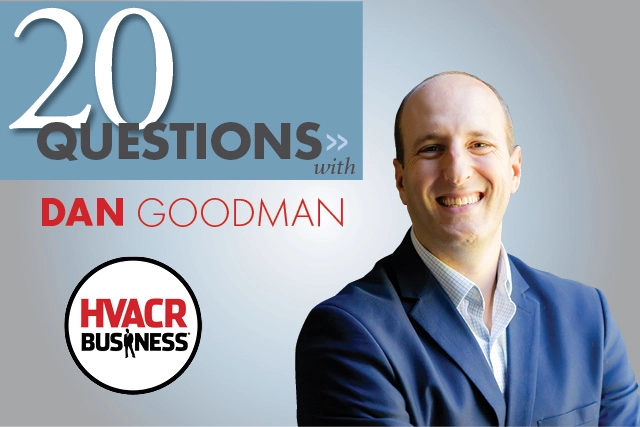Publisher Terry Tanker sat down with Dan Goodman CEO of Building36 a technology company that provides smart home solutions to HVAC, plumbing and electrical contractors. The two discussed the connected home, reduced energy costs, smart maintenance agreements and electronic tools that tie the contractor to their customers for improved service and better customer service.
1. After attending MIT what were your plans?
I discovered two things at MIT. First was a passion for electronics, and second was that I liked working with people. I wanted to find a way to bring technology to people in a way that wouldn’t require others to have an electrical engineering degree.
2. What is your business background?
After college, I went to work for Texas Instruments as a sales engineer. I helped companies design products around TI’s microcontrollers. I worked with a broad range of companies, for example Honeywell, Emerson, Bosch, Milwaukee and Whirlpool.
3. Can you explain the name Building36?
When Craig Heffernan, our CTO, and I were at MIT, the computer science building was named Building36. When we started the company we realized the technologies we were developing all started with ideas we had back in school inside Building36, so Building36 Technologies stuck.
4. You played basketball at MIT. What did sports teach you about life?
Perseverance, dedication and teamwork. When you play Division III basketball, there are no scholarships or special benefits. Players were there because they loved playing ball. Like most athletes, we needed to manage a course load, homework, labs, and more. The critical lesson I learned was how to build mental toughness.
5. What did sports teach you about business?
Sports and business are incredibly similar. In both, you have hard days and stiff competition that is always looking to beat you. The hard work you put in builds mental toughness which lets you rise up to any challenge and lead by example.
6. How long were you with TI?
Four years, and during that time, the trend clearly pointed toward getting products on the internet. I joined a startup that made low power wireless chips to help devices communicate. A big win was getting our chips designed into a smart meter. California electric utilities wanted to prevent rolling blackouts during periods of peak electric demand by sending signals through smart meters to set back thermostats.
7. How did you get started in HVAC?
In 2007 I co-founded Radio Thermostat Company of America. We made the first Wi-Fi thermostat. It was sold at Home Depot under the 3M Filtrete brand. We also made thermostats that we white labeled or integrated with residential security systems for companies like Alarm.com, Vivint, GE Security (acquired by UTC), 2Gig (acquired by Nortek), as well as cable companies like Comcast, Time Warner, Rogers and Cox.
8. What made you want to strike out on your own?
As SoCal Edison set out to deploy 5 million smart meters, I saw an opportunity. They needed a thermostat that could communicate with their smart meters. This was the beginning of the battle for ownership of the smart home. Cable companies, wireless phone companies, and security companies all wanted to leverage the smart home as a sticky method to retain customers.
9. What was your Ah-Ha moment?
I realized we were missing the most important part of the HVAC business – the contractor! Most thermostat companies sell their thermostats at retail. While a thermostat can be easy to install, the next step is complicated, for example, when something goes wrong with the system.
10. What happened to Radio Thermostat Company?
It’s still a supplier to many of our partners in the space. Often, business partnerships change and as a result, I left and started Building36 Technologies.
11. Was the plan for Building36 to tie the customer and the contractor together from the start?
Yes, when something breaks, you need a professional to diagnose, repair and or replace your equipment. It’s not a DIY project. We wanted to eliminate stress for customers by making sure they were relying on a trusted professional. Our vision was that we could use our background in technology to easily allow professional contractors to monitor their customer’s equipment.
12. Why do contractors need to embrace home automation sooner than later?
Customers want it. Plus, competition is coming from unexpected places. Traditionally it was another HVAC company. Now tech giants want to get in-between the contractor and customer by selling direct and subcontracting the work to HVAC contractors at a reduced rate. We help build long-term customer relationships with our partners. Our solutions are installed and monitored by someone the homeowner gets to know and trust.
13. What is your offer to the contractor?
We offer home automation to help strengthen the relationship between contractors and their customers. Customers log in to a contractor branded app every day to manage systems in their home. Once the platform is installed, contractors receive notifications if there is a problem with the customers’ HVAC system. This insight empowers the contractor to turn their HVAC business from reactive to proactive, and turns one-time customers into long term partners.
14. Why should contractors partner with you?
Home automation is rapidly increasing. You can sell a Wi-Fi thermostat and get paid once or, you can sell a Building36 starter kit. It includes a thermostat and numerous other sensors for critical system monitoring generating recurring revenue, all while building a better long-term relationship with your customers.
15. How do you do that?
Take your existing maintenance plan and make it a smart plan. By including proactive monitoring as part of your maintenance plan, often you’ll know your customer has a problem at their house before they do! For example, if you sell a current plan for $199/year, offer a smart plan for $25/month instead.
16. Why is the recurring revenue model so important?
It’s how you build value in your company. If you ever decide to sell your business, the real value for the buyer is the number of customers you have under agreement. In the short term, recurring revenue can also help flatten out your business cycles.
17. What’s different about a smart maintenance agreement?
When you include the Building36 solution, you’ll be able to offer your customers an app that can control thermostats, door locks, lights, garage doors, cameras, water valves, and more. More importantly, you can monitor their HVAC, condensate pan, water heater, sump pumps, CO, and contact them when you are alerted to a problem.
18. What are the benefits of offering a smart maintenance plan?
You offer a more valuable level of service. Monitoring enables you to be proactive it simplifies repairs and really helps with customer retention. Once customers have the app they don’t want to cancel it. They love the connectivity to their home.
19. What’s the difference between your Wifi thermostat and others?
The critical difference is the relationship with the customer. With Building36 solutions, the contractor builds and maintains a relationship with the customer. Knowing exactly who to call during times of need is the peace of mind many homeowners want, which others can’t give.
20. How can a contractor find out more about Building 36?
It’s simple, just go to our website, www.building36.com or call us.






